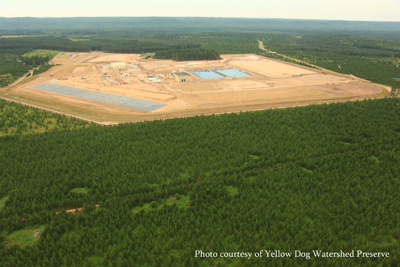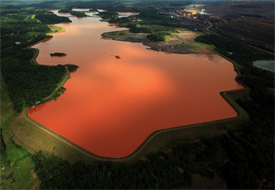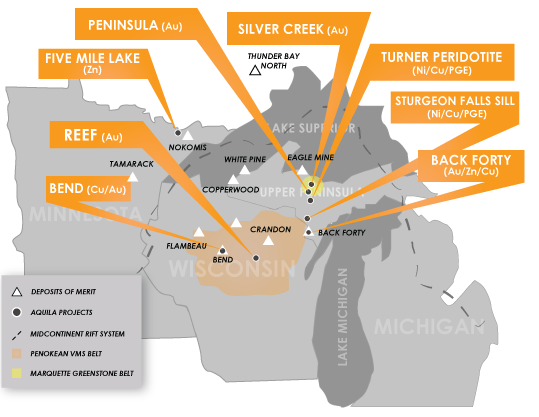Mining
 While Michigan has a history steeped in mining over the past 170 years, Anishinaabe people continue to carry on ancient cultural traditions tied to this region. The quality and health of the water, wildlife, fish, plants and medicines continue to sustain our well-being and culture. The effects of historical mineral development have included negative economic impacts associated with the boom and bust cycle of the industry, and environmental legacies that persist on our landscape today. In recent years the State of Michigan has approved nonferrous metallic mining permits for various new projects; see below for more information on each.
While Michigan has a history steeped in mining over the past 170 years, Anishinaabe people continue to carry on ancient cultural traditions tied to this region. The quality and health of the water, wildlife, fish, plants and medicines continue to sustain our well-being and culture. The effects of historical mineral development have included negative economic impacts associated with the boom and bust cycle of the industry, and environmental legacies that persist on our landscape today. In recent years the State of Michigan has approved nonferrous metallic mining permits for various new projects; see below for more information on each.
 A number of companies have been looking for metallic sulfide mineral and uranium deposits within and around the boundaries of KBIC’s L’Anse and Ontonagon Reservations in the western Upper Peninsula. Mining of such deposits and associated activities have well-known environmental management challenges, including the release of toxic metals and acid mine drainage that has caused significant irreversible impacts to groundwater and surface water systems in the United States and abroad. The KBIC Tribal Council has repeatedly identified mining as a priority concern due to its potential to significantly impact treaty rights, treaty reserved resources, area ecosystems, and the health and welfare of the community and future generations.
A number of companies have been looking for metallic sulfide mineral and uranium deposits within and around the boundaries of KBIC’s L’Anse and Ontonagon Reservations in the western Upper Peninsula. Mining of such deposits and associated activities have well-known environmental management challenges, including the release of toxic metals and acid mine drainage that has caused significant irreversible impacts to groundwater and surface water systems in the United States and abroad. The KBIC Tribal Council has repeatedly identified mining as a priority concern due to its potential to significantly impact treaty rights, treaty reserved resources, area ecosystems, and the health and welfare of the community and future generations.
The Tribal Mining Program is working to increase the community’s capacity to address mining in the 1842 ceded territory and Lake Superior basin. Staff assists in tracking mineral exploration, building technical and scientific expertise on mining related activities, informing tribal government decision-making, and ensuring tribal participation in permit processes. Another critical component of the Tribal Mining Program is to provide community outreach and education. Collecting and disseminating information on mining will help the community and public understand the issues and potential risks associated with mining. Increased community awareness will result in more active preservation of Lake Superior ecosystems, human health, tribal resources, and Anishinaabe life-ways.
Community Environmental Monitoring Program (CEMP)
Environmental monitoring includes air quality, groundwater quality, surface water quality, wildlife, plant life and more. The CEMP is independent, transparent, and based on the highest scientific standards. The Superior Watershed Partnership and KBIC’s Natural Resources Department conduct third-party monitoring of various sites, on and off reservation. Read more about CEMP, including current news and reports on KBIC's monitoring efforts.
January 2021 Joint Press Release on Mining in the Upper Peninsula
Mining Projects in Michigan
 Links to each project below, some idled, include detailed information about the mine site, potential impact and concerns, and its status.
Links to each project below, some idled, include detailed information about the mine site, potential impact and concerns, and its status.
- Eagle Mine and Humboldt Mill (active 2020)
- Copperwood Project (pending 2021)
- Tilden Mine (temporarily closed 2020)
- Empire Mine (idled 2016)
- Aquila Back Forty Project (pending 2021) *update*
- Highland Keweenaw Project (pending 2021)
- Trans Superior Mineral Exploration (ongoing 2021)
- White Pine North (pending 2021)
- Mine Updates - Department of Environment, Great Lakes, and Energy (EGLE)
News
Educational Resources
- Acid Mine Drainage: A Threat to Michigan's Water Quality Acid
- Hardrock Mining: Acid Mine Drainage
- Metallic Mineral Mining: The Process & the Price
- Metallic Sulfide Mining: A Threat to Coaster Brook Trout
- Sulfide Mining: Impacts on Michigan’s Wildlife
- The Great Lakes Fact Sheet
- Tribes and Hardrock Mining
- What Are Tailings?
- Lake Superior Page
- Mining Action Group
- Saving Buffalo Reef (video)
- Stewards of all Creation (video)
Experiments for Kids:
